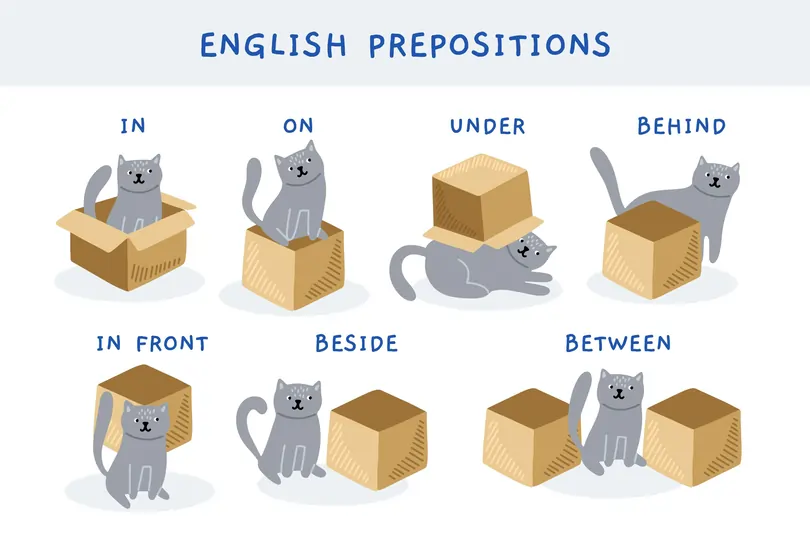Prepositions - All Types
In this article, we are going to learn about Prepositions as per the Primary 5 English syllabus. We will be focussing on the following subtopics:
- Understand the definition and use of various prepositions
- Identify where prepositions are used in a sentence to add descriptions to nouns, verbs, and adjectives.
We will also solve some questions on tenses to test out concepts on the same topic.
What are Tenses?
Tenses involve the use of verbs to indicate time. Most tenses and their aspects occur in the present or past. By looking at the tense indicated by the verb or other contextual clues in a sentence, we can identify when the actions in the sentence occurred.
To write about the future, we can include a number of words. This includes modal verbs like ‘will’ or ‘shall’ or words that help us indicate time.
Practice Questions - Tenses
Let’s test your understanding of various tenses!
Question 1:
Last Saturday, my father __________ that his dinner suit was too small, so now he follows a strict diet.
- discovers
- has discovered
- discovered
- was discovering
Answer:
3) discovered
Explanation:
Option 3 is the correct answer.
Option 1 is present tense which is wrong as in the question it is referring to “Last Saturday” i.e. it is in the PAST.
Option 2 - is present perfect -- Not correct
Option 4 - is Past Continuous - Not correct. Past continuous is used when the action happened for a while in the past. But here the discovery of the suit being tight happened in a flash. So, we cannot use the past continuous tense.
Question 2:
Helen ___________ her swimming test five times so far, unsuccessfully, but she will not give up.
- takes
- has taken
- was taking
- taking
Answer:
2) has taken
Explanation:
Option 2 is the correct answer. Helen has taken her swimming test in the past, but she is unsuccessful… however, since she is planning to take it up again, it is continuous.
Question 3:
Last year, Richard __________ his bicycle to work every day.
- rides
- riding
- rode
- ridden
Answer:
3) rode
Explanation:
Option 3 is the correct answer
Last year - Past event
Option 1 - present - wrong
Option 2 - present continuous - No information if he is still riding the bicycle. So it is wrong
Option 4 - wrong tense - past participle is used only when we have has/have/had. But we have none.
Option 3 - Past tense is the correct answer
Question 4:
More than twenty people __________ the park when the accident occurred.
- visit
- visiting
- have been visiting
- were visiting
Answer:
4) were visiting
Explanation:
Option 4 is the correct answer. It has two incidents - both of them happening concurrently. But the word ‘occurred’ tells that the incidents happened in the past. So we cannot use option 3 which is present perfect continuous.
Question 5:
I proposed the idea to my teacher even though I __________ to feel fearful about it.
- begin
- have begun
- had begun
- beginning
Answer:
3) had begun
Explanation:
Option 3 is the correct answer.
It has two incidents. The first is to start to feel fearful and the second is to propose the idea to the teacher.
Option 1 - present tense - the sentence is in the past. So wrong
Option 2 - present perfect - wrong
Option 4 - continuous - wrong as the incident already finished in the past
What are Prepositions?
A preposition is a grammatical item/ word that is used before a noun/ noun phrase/ pronoun to connect it to another word. It is normally used to show direction, time, place, or location.
Examples:
She drove to the store.
He was born in 2015.
She was waiting next to the supermarket.
He will find her at the library.
Commonly Used Prepositions of Direction/ Movement
To refer to a direction, use the following prepositions:
- To
- In
- Into
- Across
- Along
Examples:
She drove to the store.
You should turn into that street.
Drive onto the grass and park the car there.
Commonly Used Prepositions of Time
To refer to a point in time, use the following prepositions:
- In
- At
- On
- Since
- For
- By
- During
Examples:
The weather is cold in December.
She eats lunch at noon.
I go for swimming classes on Saturdays.
I have known her since 2015.
Commonly Used Prepositions of Place/ Location
To refer to a place, use the following prepositions:
- In
- At
- On
- Outside
- Inside
- Over
Examples:
He left his phone on the bed.
Place the pen inside the drawer.
The train lines have been dug under the ground.
Practice Questions - Prepositions - direction
Let’s test ourselves on prepositions of direction/ movement!
Question 1:
Be careful of oncoming traffic when you walk __________ the street!
- in
- on
- across
- along
Answer:
3) across
Explanation:
Option 3 is the correct answer.
Question 2:
The train is going __________ the tunnel.
- among
- under
- through
- above
Answer:
3) through
Explanation:
Option 3 is the correct answer
Question 3:
When we flew __________ the clouds, we could see the islands dotting the sea.
- below
- over
- through
- in
Answer:
1) below
Explanation:
Option 1 is the correct answer.
If we fly ‘over’ the clouds, then we cannot see anything below.
If we fly ‘through’ the clouds, then we see only the clouds.
The only way we can see anything below is when we fly ‘below’ the clouds.
Question 4:
Can I sit __________ you at the movie theatre, please?
- around
- between
- among
- beside
Answer:
4) beside
Explanation:
Option 4 is the correct answer.
Prepositions Following Verbs
Some verbs are followed by a preposition, which does not change the meaning of the verb.
Examples of Verb + Preposition
She often worries about her future.
The results differ from my expectations.
Bears belong to the family of mammals.
Be sure to account for any unforeseen problems.
Phrasal Verbs
When a verb + preposition is used together and produces a different meaning, we call them phrasal verbs.
Examples of Verb + Preposition (Phrasal Verbs)
We will get through this test together.
‘get through’ means overcoming or dealing with a difficult situation.
If you want, they can come along with us.
come along means to accompany someone, somewhere.
Prepositions Following Adjectives
Prepositions can sometimes appear after adjectives to complete or elaborate on the ideas, emotions, or nouns the adjective describes.
Examples of Adjective + Preposition (Phrasal Verbs)
The kitten was afraid of the loud noise. (afraid describes the kitten)
My cousin is dedicated to her studies. (dedicated refers to my cousin)
She was angry about the loud music that her neighbour played last night. (angry refers to she)
Singapore is famous for its cleanliness. (famous refers to Singapore)
Practice Questions - Prepositions + verbs/adjectives
Let’s test your understanding of prepositions + verbs!
Question 1:
A serious problem __________ after we started on the project.
- came up
- faced with
- got after
- found out
Answer:
1) came up
Explanation:
Option 1 is the correct answer.
Question 2:
I cannot believe she __________ my secret, right after I shared it with her.
- gave up
- gave away
- gave in
- gave to
Answer:
2) gave away
Explanation:
Option 2 is the correct answer
Gave up - to surrender
Gave in - to succumb
Gave away - to let the secret out
Question 3:
Why were her parents so pleased __________ her?
- about
- on
- of
- with
Answer:
4) with
Explanation:
Option 4 is the correct answer.
Question 4:
We’re so excited __________ his decision to attend that school.
- on
- of
- from
- about
Answer:
4) about
Explanation:
Option 4 is the correct answer.
Fun Facts About Prepositions
One of the most frequent debates about prepositions is whether it is acceptable to end a sentence with a preposition!
Generally, in some cases it is acceptable and it is called a terminal preposition. This was a very rigid and conservative approach, a long time ago.
Example:
What did you step on?
It is also acceptable to end a sentence with a phrasal verb.
Example:
I wish he would cheer up.
Commonly, it is used in everyday speech. It does make your written language sound more informal to the reader so choose wisely when to do so!
Conclusion
In this article, we learned about prepositions as per the Primary 5 English level. We focussed on the following subtopics:
- Prepositions can come before nouns or objects and they can be used to connect to another word
- Prepositions can also come after verbs, where it does not change the meaning of the verb.
- When a verb + preposition is used together and produces a different meaning, we call them phrasal verbs.
- Prepositions can sometimes appear after adjectives to complete or elaborate on the ideas, emotions, or nouns the adjective describes.


 SG
SG  VN
VN 


















